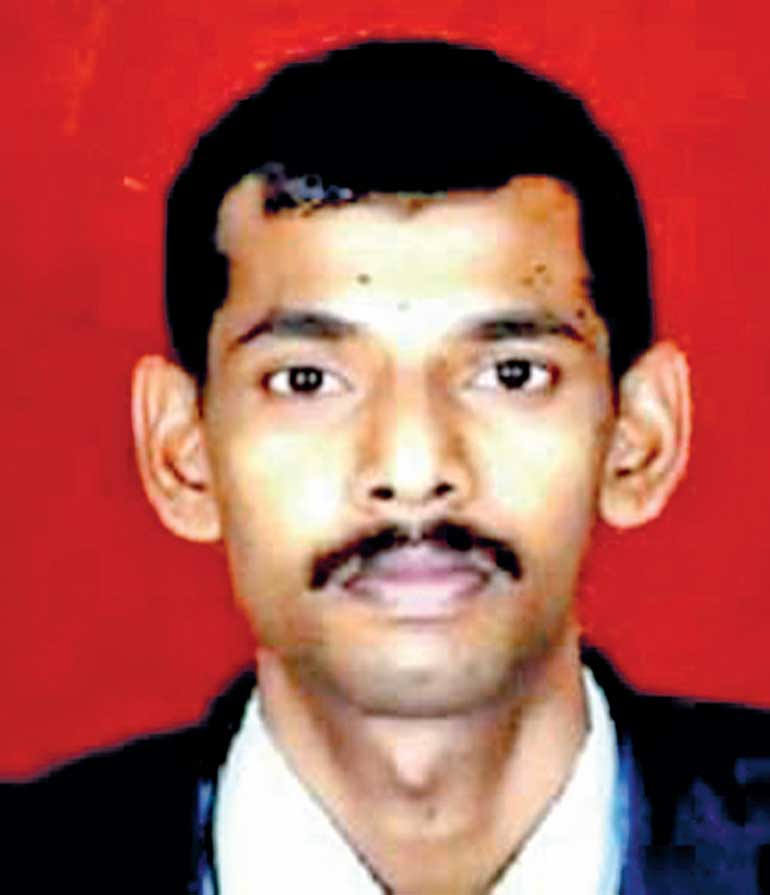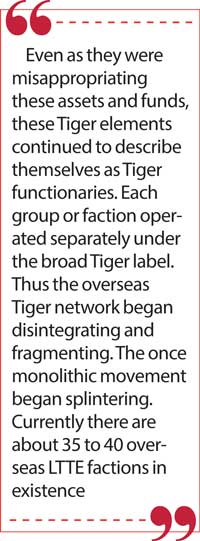How the overseas LTTE raised funds from the Tamil diaspora
Friday, 15 December 2023 00:50 – – 88

The Nediyavan network was shrouded in secrecy and ambiguity with many activists having shady, controversial pasts
 Readers have evinced a lot of interest in the contents of the first part of this article published last week. This article’s focus on the fraudulent attempt to promote an impostor as Thuvaraka the daughter of Liberation Tigers of Tamil Eelam (LTTE) leader Veluppillai Prabhakaran has evoked much response from readers. The feedback I have been getting is basically of two types.
Readers have evinced a lot of interest in the contents of the first part of this article published last week. This article’s focus on the fraudulent attempt to promote an impostor as Thuvaraka the daughter of Liberation Tigers of Tamil Eelam (LTTE) leader Veluppillai Prabhakaran has evoked much response from readers. The feedback I have been getting is basically of two types.
The first kind of response is from readers who were unaware or knew very little about this false Thuvaraka. They are intrigued and curious about this brazen attempt to hoodwink people. The second kind of response is from persons who are aware of this duplicitous exercise to some extent. Some have even experienced salient aspects of the fraud in different degrees. The input provided by these readers is proving to be invaluable. A common factor between both types is the request that I should continue to write in detail about this issue.
Before continuing, there is another related dimension that I need to explain and elaborate upon. Some readers have specifically asked me about the LTTE’s Nediyavan who was in charge of the overseas Tiger network. Since it was I who had first written about him many years ago and also referred to him briefly in this article’s first part, their queries were about Nediyavan’s role in this false Thuvaraka fraud. Apparently there had been media reports stating that Nediyavan was the mastermind behind this duplicitous exercise.
The simple answer is “no, Nediyavan is not involved in this”. Though Nediyavan was at one time the powerful overseas head of the LTTE, in recent times he has become very inactive and is practically “retired”. What has happened is that the once monolithic LTTE overseas network is now fragmented. There is no single point of control or authority. As a result several Tiger outfits are now functioning autonomously. It is a Switzerland based faction of the Tigers that is behind this Thuvaraka fraud. They are aided and abetted by individuals and small groups in other countries. However Nediyavan’s decline has a direct bearing on the current situation.
Sivaparan alias Nediyavan
In this context the rise and fall of Nediyavan needs to be recounted here. Perinbanayagam Sivaparan alias “Nediyavan” is from Sangarathai, Vaddukkoddai in Valigamam West, Jaffna. His nom de guerre “Nediyavan” means ‘tall man’. 47-year-old Nediyavan joined the LTTE in 1994 when he was 18. He was sent to Russia for higher studies by the LTTE and studied political science but did not complete his degree in Moscow.
Interestingly the financial arrangements for Nediyavan’s studies in Russia were handled by Selvarasah Pathmanathan alias “KP” who took a personal interest in the youngster. KP who was in charge of overseas administration, fund raising and procurement before 2002, got someone in France to send money regularly to Nediyavan. Ironically, the very same Nediyavan turned against KP later and backstabbed him.
 Nediyavan functioned in the LTTE’s political wing and accompanied former Tiger political commissar Suppiah Paramu Thamilselvan for some of the peace talks held during 2002-2003. He was later transferred to the overseas LTTE administration section under Veeragathy Manivannan alias Castro. Nediyavan was in charge of Castro’s public relations unit and interacted with several overseas functionaries visiting the Wanni during the Oslo facilitated peace process.
Nediyavan functioned in the LTTE’s political wing and accompanied former Tiger political commissar Suppiah Paramu Thamilselvan for some of the peace talks held during 2002-2003. He was later transferred to the overseas LTTE administration section under Veeragathy Manivannan alias Castro. Nediyavan was in charge of Castro’s public relations unit and interacted with several overseas functionaries visiting the Wanni during the Oslo facilitated peace process.
It was then that Nediyavan met his future wife Sivagowri Shanthamohan. She was a Norwegian citizen. Her father’s brother was Gnanendramohan alias Ranjan Lala. Gnanendramohan was one of the pioneering members of the LTTE and a trusted confidante of Prabhakaran. Ranjan Lala was shot in Jaffna by the Army when riding a motor cycle.
Many young, unmarried female Tiger supporters who visited the LTTE controlled areas of the Northern mainland Wanni during the peace process found themselves unable to resist the “five flowery arrows” of “Manmathan” or cupid when they interacted with young Tamil male Tiger militants. Sivaparan and Sivagowri fell in love. Prabhakaran who had been very fond of Ranjan Lala supported the union.
Went to Norway
After their marriage, Sivaparan went to Norway in 2006. The LTTE had been sending a number of operatives abroad over the years. These cadres belonged to different departments of the LTTE and began functioning as Tiger operatives in these new countries. Most of these cadres were from the political and intelligence wings.
Nediyavan took up residence in Norway. The matrimonial alliance with Sivagowri had strengthened Nediyavan’s clout within the LTTE. Castro used him to communicate with overseas operatives. Contact between the Wanni and Tigers abroad was under strain as the war escalated. So Castro appointed an international representative on his behalf. This person was to be in overall charge of the LTTE overseas branches. This was none other than Nediyavan.
Selvarasa Pathmanathan alias KP, who at one time was in charge of overseas LTTE branches re-joined the LTTE and was appointed head of international relations in January 2009. He, with Prabhakaran’s approval, used this position to re-establish control of the overseas LTTE. This was resented by Castro. With Castro’s authority, Nediyavan spearheaded resistance to KP taking over as global Tiger chief. A key factor in this was KP’s insistence that Nediyavan should submit detailed accounts of financial expenses to him. Since a lot of corruption prevailed then, Nediyavan was reluctant to do so.
This resistance continued even after the LTTE leadership was destroyed in May 2009. While KP donned the leadership mantle on account of his seniority, Nediyavan and his loyalists opposed it. After KP was arrested in Malaysia and deported to Sri Lanka in August 2009, Nediyavan established greater control over the overseas LTTE structures.
Nediyavan’s network
Nediyavan’s network primarily consisted of one-time LTTE branches and front organisations. With the LTTE being proscribed as a foreign terrorist organisation in most Western nations many of the identified Tiger branches became dormant or transformed themselves into new entities. New fronts were also established. The Nediyavan group also established a network of “elected” organisations in different countries among the Tamil diaspora. These organisations were called either “Makkal Peravai” or “Thesiyap Peravai” (Peoples or National Assemblies or Councils) in each country. While these functionaries tried to project themselves as democratic political activists at one level, many of them at other levels were involved in shady activity. This was because these outfits were fundamentally LTTE branches pretending to be legitimate political formations.
Thus the Nediyavan network, despite its pretensions to the contrary was not transparent or accountable. Moreover, the Nediyavan network was shrouded in secrecy and ambiguity with many activists having shady, controversial pasts. Political statements made by the Nediyavan group were released by the LTTE office calling itself the “Anaithulaga Seyalagam” (International Secretariat or office).
Meanwhile, the Sri Lankan authorities requested Norway to hand over Nediyavan to them some years ago. Oslo did not oblige but Norwegian officials interviewed Nediyavan and warned him that he should not engage in or promote violence while living on Norwegian soil. Thereafter Norwegian officials monitored Nediyavan closely and also pressured him intensely to desist from Tiger activities.
Nediyavan then relocated from Oslo to a place near Bergen which is about 460 km away from Oslo. He began maintaining a low profile and gradually became inaccessible to Tiger operatives. While his wife works as a physiotherapist, Sivaparan is employed at a daycare centre. According to informed Norwegian sources, Nediyavan is no longer functioning as the LTTE overseas chief.
Chiranjeevi Master and Abdullah
 Viewed against this backdrop, it appears that the ongoing false Thuvaraka fraud is essentially a Swiss scam that has nothing to do with Nediyavan. The two Tiger stalwarts behind this fraudulent racket are Jeevaratnam Jeevakumar alias Chiranjeevi master and Chellia Jeyapalan alias Abdullah. Chiranjeevi master is a former deputy of ex-LTTE intelligence chief Pottu Ammaan. The plan devised by Chiranjeevi master is being allegedly executed by Abdullah who is a former financial head of the LTTE’s Switzerland network.
Viewed against this backdrop, it appears that the ongoing false Thuvaraka fraud is essentially a Swiss scam that has nothing to do with Nediyavan. The two Tiger stalwarts behind this fraudulent racket are Jeevaratnam Jeevakumar alias Chiranjeevi master and Chellia Jeyapalan alias Abdullah. Chiranjeevi master is a former deputy of ex-LTTE intelligence chief Pottu Ammaan. The plan devised by Chiranjeevi master is being allegedly executed by Abdullah who is a former financial head of the LTTE’s Switzerland network.
Abdullah was mainly responsible for the LTTE fund raising drive in Switzerland shortly before the war ended in 2009. The money collected was not sent to the LTTE in the Wanni. Instead it was embezzled by Tiger operatives in the Diaspora. In order to comprehend the implications and ramifications of this fraud, it is essential to understand how the LTTE fundraising mechanism operated abroad in the years before the war ended. There were generally five modes.
Standing order
The first was the mode known as “SO” or standing order. This is a method by which committed supporters of the LTTE made arrangements through their banks for a monthly sum to be sent directly to the front organisation of the LTTE in his or her country. This was comparatively a small sum but had regularity and reliability guaranteed. There was no coercion in this because those who contributed were genuine supporters who did so willingly. The funds raised through this method were used for the running of LTTE branches/fronts in each country and not sent to Sri Lanka or used to buy arms.
General collection
The second was the annual general collection. This was a collection drive executed on an ongoing basis throughout the years. In this, many Tamils regardless of whether they were active supporters or not were targeted. Pledges were extracted for certain sums of money to be paid in a few instalments. Force, intimidation and coercion were used frequently in these collection drives to make people pay up or increase the sums of money promised. An easy way of frightening Tamils was by threatening harm to family members living in Sri Lanka. A large number of people paid up willingly too.
Earlier, Tiger collectors used to work on a voluntary basis but later the collectors were paid a commission depending on the amount they collected. This incentive resulted in a massive increase in fundraising. At the same time, enthusiastic collectors engaged in violence and intimidation to increase the amount collected as their own income through commissions too increased proportionately. In France, LTTE collectors had a farm outside Paris where abducted Tamils were taken and held as captives until ransoms were paid or huge amounts of cash pledged as “donations.”
The money raised through these collections was spent in three ways. A substantial portion of it was sent to the LTTE headquarters in Wanni for maintenance and upkeep of the movement. Another portion was sent to procurement agents abroad for arms and ammunition purchases. A third and perhaps the largest portion was used for investment and setting up businesses abroad.
“Special” collection
 The third form of fundraising was the one known as “special collection.” This is actually a kind of credit or loan arrangement used exclusively to facilitate acquisition of arms. This concept was pioneered by Selvarasah Pathmanathan alias KP decades ago when he was in charge of the LTTE overseas procurement or arms purchases.
The third form of fundraising was the one known as “special collection.” This is actually a kind of credit or loan arrangement used exclusively to facilitate acquisition of arms. This concept was pioneered by Selvarasah Pathmanathan alias KP decades ago when he was in charge of the LTTE overseas procurement or arms purchases.
What happened then was that huge amounts of money were required at short notice to make arms purchases. KP, who was then in overall charge of overseas LTTE administration and fundraising, hit upon the idea of a special collection to raise funds at short notice.
A special collection was one where trusted, diehard supporters of the LTTE in each country, particularly those whose credit was good with banks, would obtain loans in their names and then transfer the money to the local LTTE agent or front. In most instances, they would use their line of credit or put up their houses as collateral to get loans.
By this method, a huge amount of money would be secured rapidly and utilised for arms purchases. The interest due to the banks for these loans would be given by the local LTTE branch through the funds obtained through standing orders. While the interest was paid off regularly in this way, the principal was also paid off gradually through the money raised by the general collection.
KP made sure that all loans procured by Tiger supporters in their personal capacity for a special collection was paid off without default in due course. His successors too followed suit. Thus, the special collection idea caught on among LTTE supporters and exceedingly large amounts were raised and paid off without mishap. A special collection was usually undertaken once in eighteen months.
Staging events/selling stuff
Apart from these three modes, there were two other broad methods to generate funds. One was by staging performances and shows and by selling stuff like calendars, videos, DVDs, Audio CDs, books, magazines, newspapers and souvenirs. Money was also raised by staging events like Black Tigers Day and Great Heroes Day along with related celebrations. On the one hand, people were charged large amounts for admission while on the other, people were also pressured to make donations to cover the expenses. Since these events exploited the emotions of people, it was possible to extract huge sums easily.
Commercial investment
Finally, there was the investment in commercial concerns. The LTTE justified its entry into pure commercial pursuits by stating that avenues of regular income should be ensured to sustain the armed struggle at all times. Since reliance on contributions alone could prove unsteady in the long run, the Tigers needed to set up commercial enterprises on a wide-ranging basis, it was argued.
Once LTTE supremo Velupillai Prabhakaran gave his consent, the floodgates were opened. The LTTE branches engaged in different types of businesses through front agents or “benamis.” Screening Tamil films, running restaurants and takeout food outlets, operating real estate services, grocery shops, jewellery stores, printing presses, construction, money transfer services, property development, computer services and trucking were some of the enterprises the Tigers were engaged in.
Some businesses were started anew while in many instances, the Tigers pumped in money to existing ones and acquired control. These businesses paid part of the profits to the LTTE while in some instances those running the businesses were paid regular salaries. Since these businesses and services were originally started by people independently, the community at large did not suspect or know about subsequent Tiger infiltration and acquisition of these enterprises.
Abuse and corruption
There was much “abuse and corruption” in this regard as most of the front agents were relatives or close associates of prominent LTTE stalwarts. For instance, the brothers of a well-known senior LTTE leader who is no more were not known to hold a steady job for several years in the country they were living in. Suddenly, both became very prosperous. Today, one brother is the owner of many buildings given on rent while the other owns a fleet of trucks.
Even when the LTTE was active in Sri Lanka, some of the people running Tiger businesses abroad began siphoning off cash clandestinely. Several LTTE-run businesses went bankrupt while others continued to “show” loss. After the Mullivaikkal debacle of May 2009, many running these businesses as benamis have appropriated them. Some sold off the businesses and buildings and pocketed the cash themselves.
Overseas LTTE fragmentation
Even as they were misappropriating these assets and funds, these Tiger elements continued to describe themselves as Tiger functionaries. Each group or faction operated separately under the broad Tiger label. Thus the overseas Tiger network began disintegrating and fragmenting. The once monolithic movement began splintering. Currently there are about 35 to 40 overseas LTTE factions in existence.
These Tiger elements face a two-fold problem. The first is to hold on or retain the funds and assets they possess in the name of the LTTE. The second is to keep generating more funds from the diaspora. There is pressure from LTTE supporters and sympathisers that the assets and funds should be returned to the people or be sent to Sri Lanka to aid poorer sections of Tamil society. Tamils in the diaspora are not donating to the Tamil cause as in the past because they opine that the struggle has ended.
Twin problems
It is in such a situation that the false Thuvaraka Prabhakaran fraud has been set in motion. Those behind this deception calculate that the twin problems of retaining funds and assets as well as reviving financial donations from the public can be resolved through this fraudulent exercise. These matters will be delved into in greater depth in the third part of this article.
(The writer can be reached at dbsjeyaraj@yahoo.com.)






